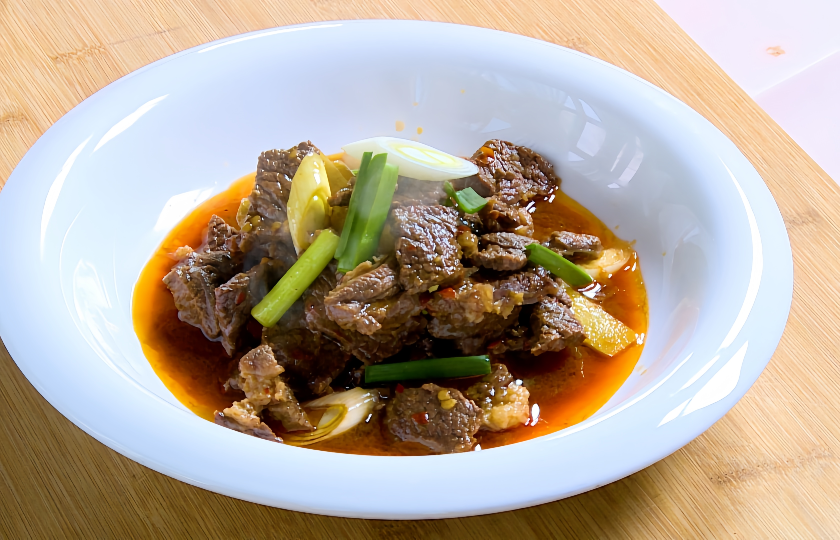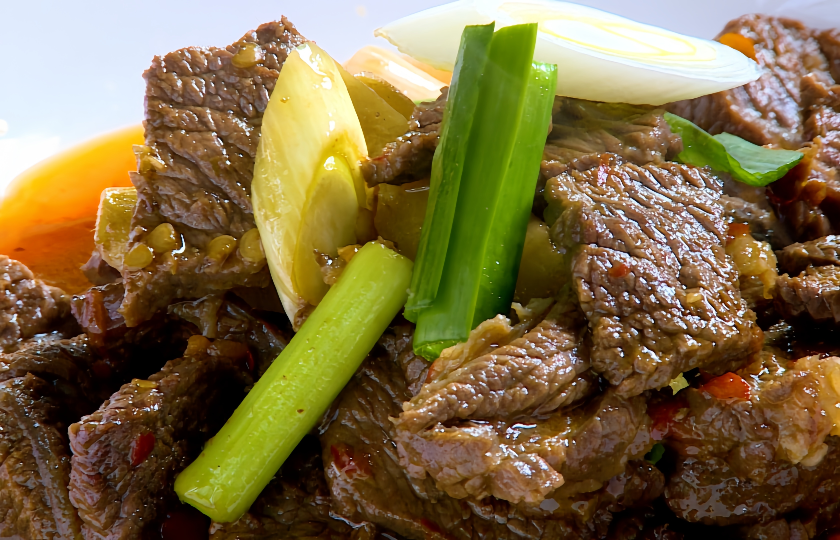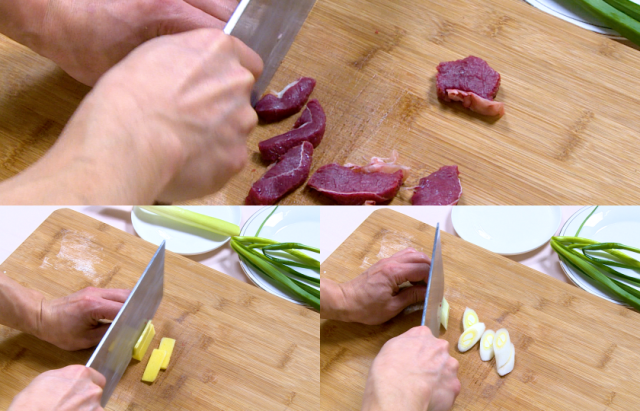Skillful Braised Beef Recipe: The Art of Slow Cooking


In the cold winter days, braised beef is synonymous with warmth. A steaming pot of beef is braised until it is soft and flavorful. Every bite is warm, warming from the mouth to the stomach and then spreading throughout the body. That warmth is like the warm sun in winter, dispelling the cold and giving you a full sense of happiness and security. It is a must-have delicacy for nourishing and warming the body in winter.
Ingredients Needed and Substitutions
Main ingredients
Beef: Rich in protein, providing a solid chewiness and a rich meaty aroma, it is the core.
Accessories
Green onions: The volatile components remove fishy smell and greasiness and give a fresh and unique onion fragrance.
Ginger: Gingerol plays a role in removing fishy smell and stimulating the natural umami of beef.
Seasonings
Salt: Basic seasoning. Precisely controlling the saltiness highlights the original taste of the ingredients.
Soy sauce: Achieves coloring and enhancing freshness, making the color and taste of beef better.
Bean paste: The unique spicy and savory flavor of the bean paste permeates, adding a rich layer of flavor.
Star anise: With its volatile oil, it emits a five-spice aroma, removing fishy and muttony smell and adding a rich background.
Oil: As a heat-conducting medium, it helps in cooking and blending various flavors.
Substitutions
Beef: Can be replaced with mutton and adjust the cooking time; or choose pork, with a different flavor.
Green onions: Onions can be used as a substitute. They have a sweet fragrance and remove fishy smell, but the onion fragrance characteristics are different.
Ginger: Ginger powder can be used in an emergency, but the aroma concentration and naturalness are inferior to fresh ginger.
Bean paste: Use a mixture of chopped chili peppers and sweet flour paste. The flavor will be different.
Star anise: Can be replaced with five-spice powder. The aroma is less mellow and the concentration is slightly lower.

Tips and techniques
Beef pretreatment: Choose parts such as brisket and beef shank that have tendons and meat for a good taste. Cut into large pieces. Put them in cold water and add ginger slices and cooking wine for blanching. Skim off the foam and take out and drain. This can remove fishy smell and keep the meat firm.
Fry the base ingredients: Heat oil in the pot. Add green onions, ginger, garlic and star anise and stir-fry until fragrant. Then add bean paste and stir-fry on low heat to bring out the red oil and bean paste aroma, laying a flavor foundation for the beef. Pay attention to the heat and don't burn it.
Key points for braising: After stir-frying the beef, add hot water to cover the beef. Use a casserole or pressure cooker. Braise in a casserole for 1.5 - 2 hours. The meat will be soft and flavorful. After the pressure cooker is pressurized, cook for 30 - 40 minutes. It saves time and the meat will not be tough. Add salt for seasoning at the right time during braising. Adding salt too early can easily cause the meat to lose water and become tough.
Enhancing flavor and color: Add soy sauce in two times. Add a small amount when stir-frying for coloring. Add a little more in the middle of braising to enhance freshness and color. You can add rock sugar according to your preference to neutralize the spiciness and enrich the flavor profile, making the color more shiny and attractive.
The best beef cuts for braising
The suitable beef cuts for braising each have their own characteristics. Brisket is taken from the abdomen and near the ribs of the cow. The meat has alternating layers of fat and lean, with tendons and meat. It is tender and juicy. After braising, it is soft and flavorful, with a combination of chewiness and tenderness. It is suitable for dishes like potato braised beef and tomato braised brisket. It has strong ability to absorb juice and has a rich flavor.
Beef shank is the meat from the cow's leg. It has a firm texture and thick fibers. There are distinct tendons in the middle. After long hours of braising, the meat does not lose its toughness. The tendons are soft and chewy, presenting a rich layered texture. It is often used in spiced beef and five-spice braised beef. The unique flavor is highlighted by spices.
Oxtail has tender meat and rich bone marrow, full of collagen. Braising makes the soup thick and delicious. The meat is soft and mellow. The unique shape adds some attraction. Made into oxtail soup or red wine braised oxtail, the flavor is fully displayed.
Shoulder meat (flat iron) is in the front shoulder part of the cow. It has little fat and fine fibers. After braising, it is soft and tender. It is economical and cost-effective. It is suitable for clear braising or making braised dishes with radish. It is light but not lacking in deliciousness.
What vegetables to pair with
Among root vegetables, potatoes are soft and starchy, which can increase the thickness of the soup. They absorb the meaty aroma. Cut them into pieces and put them in after the beef has been braised for a while. Carrots are sweet and rich in nutrition. They balance the saltiness and add sweetness. Cut them into rolling cuts and put them in at the same time as potatoes. Then braise for another 20 - 30 minutes. Onions have a unique aroma and contain sulfides. At the initial stage, stir-fry them with beef to remove fishy smell and enhance fragrance.
In mushrooms, shiitake mushrooms are "mountain delicacies". They have a strong aroma and thick flesh. Soak dried products in advance and put them in the middle of braising. Oyster mushrooms are fresh and inexpensive. Tear them into small pieces and put them in 10 - 15 minutes before serving. They absorb the umami fully.
For other vegetables, tomatoes are sour and sweet. They contain vitamin C and lycopene. Cut fresh ones into pieces and stir-fry them to bring out the juice first and then braise. Or use canned products to add a rich flavor. They help the beef become soft and remove greasiness. Celery has a unique fragrance and is rich in dietary fiber. Cut it into sections and add it 5 - 10 minutes before serving to add a fresh feeling and aid digestion.
Other cooking methods
Tomato braised beef: Use the sour and sweet taste of tomatoes to enhance freshness and remove greasiness, giving the beef a refreshing flavor. Cut the beef into pieces and blanch them first. After stir-frying green onions, ginger and garlic with hot oil, stir-fry the beef. Add enough tomato pieces and stir-fry to bring out the juice. Add water to cover the ingredients. Put in side dishes like potatoes and onions. Braise on low heat until the beef is soft and the soup is thick. The sour and sweet taste is fully integrated. No need for too many additional seasonings, highlighting the original taste of the ingredients.
Red wine braised beef: It has a Western romantic style. Cut the beef into pieces and marinate them for several hours with red wine, minced onions, thyme and other seasonings to let the wine and spices penetrate into the meat. During cooking, first fry the beef until the surface changes color. After taking it out, stir-fry vegetables like carrots and celery. Pour in red wine and beef stock. Put in the beef and braise slowly. The fruity aroma and spice flavor of the wine blend during heating. After braising, the meat is fragrant and the color is bright red.
Curry braised beef: After processing the beef, put it in the pot. Add oil and stir-fry to dry the moisture. Add curry cubes, potatoes, coconut milk, etc. and braise on low heat. The curry has a strong spicy and fragrant flavor. The potatoes absorb the soup and become soft and glutinous. Coconut milk adds a smooth milky aroma. The collision of spiciness, fragrance, sweetness and saltiness creates a unique flavor that is very delicious with rice.
Clear braised beef: It emphasizes highlighting the pure original taste of beef. Only use green onions, ginger, pepper and salt for seasoning. After cutting the beef into pieces and blanching, add enough clear water and braise on low heat until the meat is tender and the soup is clear and fresh. Take a sip of the soup and taste a piece of meat. The original taste fully shows a simple and delicious flavor.
INGREDIENTS
Main Ingredients
-
·500g beef
Additional Ingredients
-
·100g green onions
-
·10g ginger
Seasonings
-
·5g salt
-
·10ml soy sauce
-
·10g bean paste
-
·3-5 pieces star anise
-
·5ml oil
COOKING STEP
Step 1
Preparation of ingredients: First, clean the beef thoroughly. Then, cut it into slices about 0.5 centimeters thick. Cut ginger into thin slices and scallions into sections and set aside.

Step 2
Fry seasonings to release fragrance: Pour an appropriate amount of oil into the pan. Add ginger slices and star anise. Stir-fry over medium-low heat until a fragrant aroma is emitted.

Step 3
Stir-fry beef: Put the sliced beef into the pan. Stir-fry quickly over high heat until the surface of the beef changes color.

Step 4
Add seasonings: Pour in salt, broad bean paste and soy sauce. Continue to stir evenly to allow the beef to fully absorb the flavors of the seasonings.

Step 5
Add water and simmer: Add an appropriate amount of clear water to ensure that the water surface covers the beef. After bringing it to a boil over high heat, turn to low heat and simmer.

Step 6
Simmer until cooked: Simmer for about 20 to 30 minutes until the beef is thoroughly cooked and the soup thickens.

Step 7
Season and take out of the pan: Add an appropriate amount of salt according to personal taste. Sprinkle with minced garlic and scallion sections. Stir evenly.

More recipes worth trying
Radish And Pork Ribs Soup Recipe
Chinese Herbal Chicken Soup Recipe
Eating suggestions
Enjoy while it's hot: When the braised beef is just out of the pot and steaming hot, the fragrance is the most intense and the taste is the best. At this time, the beef is soft and the soup is thick. Whether eating the meat directly or using the soup to soak rice or mix noodles, you can experience its deliciousness to the greatest extent. As the temperature drops, the oil congeals and the taste will be slightly reduced.
Pair with staple foods: Pairing with rice is a classic combination. The rich meaty aroma and soft glutinous rice complement each other. Pour a spoonful of beef and soup on it to instantly enhance the color and flavor of plain rice. Pairing with noodles, you can use the braised beef and soup as toppings to make beef noodle soup. The noodles absorb the thick soup and have both chewiness and deliciousness. You can also pair with steamed buns and pancakes. Put a few pieces of beef in and dip it in some soup. It's filling and delicious.
Pair with sauces: If you like sour and spicy flavors, you can prepare a dipping sauce mixed with vinegar and chili oil. Dip the beef in it to add a touch of stimulation to the mellow taste.
FAQs:
Beef shank has tight meat and distinct tendons. In an ordinary pot, it takes 2 to 2.5 hours to ensure the meat is tough and the tendons are soft and springy. In a pressure cooker, it takes 40 to 50 minutes to basically become soft and tender.
Oxtail contains a lot of collagen and tender meat. In an ordinary pot, it takes 1.5 to 2 hours for the meat to be tender and the soup to be thick. In a pressure cooker, it takes 35 to 45 minutes after being pressurized to reach a soft and tender degree.
In terms of cooking tools, ordinary pots like casseroles are evenly heated and heat up slowly. Although it takes 1.5 to 2.5 hours, it can make the beef fully release its flavor and blend into the soup.
Pressure cookers increase the boiling point by high pressure and greatly shorten the time, which is 1/3 to 1/2 of that of ordinary pots. The meat can be soft and tender, but the intensity of the flavor is slightly weaker.
Cast iron pots have strong heat storage capacity, heat up quickly and maintain a constant temperature. They can quickly lock in moisture and give the beef surface a charred fragrance. The inside continues to be heated until it is soft and tender. They are durable and versatile. They are just right for making dishes like red wine braised beef that need to be fried first and then braised, with a unique flavor.
Pressure cookers increase the boiling point by high pressure. The beef becomes soft and tender in a short time and also reduces nutrient loss. It is suitable for busy daily life. If you want to quickly enjoy braised beef on weekdays, choosing it is convenient and efficient. However, since cooking is fast, seasoning must be accurately controlled to ensure that the meat fully absorbs the flavor. With these diverse advantages, it has become a popular pot for braising beef in the kitchen.
In the middle stage, after adding water, turn to medium-low heat. In an ordinary pot, let the soup simmer slightly and evenly transfer heat to help braise the beef slowly. Brisket takes about 1-1.5 hours and beef shank takes 1.5-2 hours. After the pressure cooker is pressurized, turn to this gear. Relying on pressure to shorten the time, brisket can become soft and tender in 30-40 minutes.
In the later stage, the ending is different. In an ordinary pot, when the beef is soft and tender, turn to low heat and slowly simmer for 10-15 minutes to thicken the soup and increase the degree of flavor. For pressure cookers, turn off the heat and wait for the pressure to be released naturally. Only in this way can soft, tender and flavorful beef with thick soup be braised.
The advantage of frozen storage is that low temperature inhibits the activity of microorganisms and enzymes. The temperature in the refrigerator's freezer compartment is about -18℃ or below. Beef can be kept fresh for 3-6 months. But freezing will cause the water in the meat to freeze. Ice crystals will damage the cell structure. After thawing, the taste may be slightly loose and worse. Therefore, if you want to eat it in a short time, you can refrigerate it. If you want to store it for a long time, choose freezing. And check every time you take it out. If there are any abnormal conditions such as peculiar smell, discoloration, mold, etc., it must not be eaten again.

















